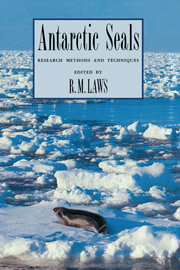Book contents
- Frontmatter
- Contents
- List of contributors
- Preface
- Introduction
- 1 Identification of species
- 2 Estimation of population sizes
- 3 Immobilization and capture
- 4 Marking techniques
- 5 Telemetry and electronic technology
- 6 Behaviour
- 7 Killing methods
- 8 Morphometrics, specimen collection and preservation
- 9 Genetic-based studies for stock separation
- 10 Collection of material for the determination of organochlorine and heavy metal levels
- 11 Age determination
- 12 Reproduction
- 13 Diet
- 14 Bioenergetics
- 15 Development of technology and research needs
- 16 Appendices
- Index
14 - Bioenergetics
Published online by Cambridge University Press: 05 February 2010
- Frontmatter
- Contents
- List of contributors
- Preface
- Introduction
- 1 Identification of species
- 2 Estimation of population sizes
- 3 Immobilization and capture
- 4 Marking techniques
- 5 Telemetry and electronic technology
- 6 Behaviour
- 7 Killing methods
- 8 Morphometrics, specimen collection and preservation
- 9 Genetic-based studies for stock separation
- 10 Collection of material for the determination of organochlorine and heavy metal levels
- 11 Age determination
- 12 Reproduction
- 13 Diet
- 14 Bioenergetics
- 15 Development of technology and research needs
- 16 Appendices
- Index
Summary
Introduction
The study of bioenergetics offers powerful methods for quantifying many aspects of animal life histories and, more importantly, provides a common currency in the form of energy units for making comparisons across species. Seals provide excellent opportunities for examining specific topics, such as the costs of reproduction, parental investment and the energetics of foraging, although there are logistical problems which must be considered when studying large animals in remote places. The separation of feeding and breeding which characterizes most phocid seal life histories makes the estimation of energy costs of reproduction relatively simple. The animals fuel their requirements from stored body resources and thus it is necessary to measure only energy output. The pupping and mating seasons are discrete and well-synchronized, and the animals are relatively accessible because they spend all or most of their time out of the water. Parental investment is provided solely by the female and is terminated abruptly by her departure. In otariid seals, care of the young is similarly the prerogative of the female, although the estimation of reproductive costs in this group is complicated by the alternation of feeding and lactation bouts. There is the compensatory advantage that the predictable return of females to their young enables studies to be made of foraging costs.
In this chapter we propose to list some of the questions that might be asked in bioenergetic studies of seals and to cover in detail the techniques which can be used to address them.
- Type
- Chapter
- Information
- Antarctic SealsResearch Methods and Techniques, pp. 291 - 315Publisher: Cambridge University PressPrint publication year: 1993
- 2
- Cited by



